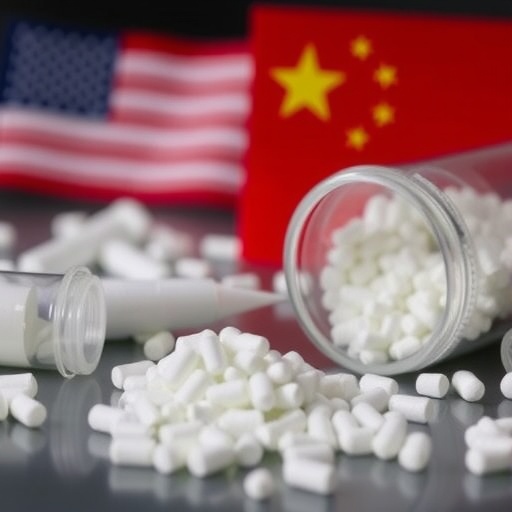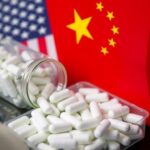US and China Forge Historic Pact to Stem Fentanyl Precursor Chemicals Flow Amid Escalating Opioid Crisis
In a groundbreaking development amid tense trade negotiations, the United States and China have reached an agreement for Beijing to crack down on the export of precursor chemicals essential for producing Fentanyl, the synthetic opioid ravaging communities across America. This US-China cooperation marks a pivotal shift in addressing the Fentanyl-driven opioid crisis, which claimed over 70,000 lives in the US last year alone, according to the Centers for Disease Control and Prevention (CDC). Officials hailed the deal as a “game-changer” for public health, potentially disrupting the illicit supply chains that have fueled this epidemic.
- Disrupting the Illicit Pipeline: Key Provisions of the US-China Fentanyl Accord
- Fentanyl’s Ravaging Impact: A Public Health Emergency in Numbers
- From Accusations to Alliance: The Rocky Road to US-China Cooperation on Fentanyl
- Voices from the Frontlines: Experts and Advocates Weigh the Fentanyl Deal’s Promise
The announcement came during high-level talks in Geneva, where US Treasury Secretary Janet Yellen and Chinese Vice Premier He Lifeng discussed broader economic issues. While trade tariffs and technology transfers dominated headlines, the fentanyl precursor chemicals accord emerged as an unexpected bright spot. Under the pact, China commits to enhanced regulatory oversight, stricter export controls, and intelligence-sharing with US authorities to identify and halt shipments of key chemicals like 4-anilino-N-phenethylpiperidine (ANPP) and norfentanyl, which are routinely diverted for illegal fentanyl production.
This agreement isn’t just diplomatic posturing; it’s a direct response to years of advocacy from US lawmakers and health experts who have long pointed to China as the primary source of these precursor chemicals. Fentanyl, 50 times more potent than heroin, has surged into the US via Mexican cartels who synthesize it using Chinese-sourced materials, exacerbating the opioid crisis that costs the nation over $1 trillion annually in healthcare, lost productivity, and criminal justice expenses, per a 2023 report from the RAND Corporation.
Disrupting the Illicit Pipeline: Key Provisions of the US-China Fentanyl Accord
At the heart of this US-China cooperation is a multifaceted strategy targeting precursor chemicals at their source. Chinese authorities have pledged to implement a new licensing system for exporting over 25 regulated chemicals, including those flagged by the UN Office on Drugs and Crime as high-risk for fentanyl synthesis. This includes real-time monitoring of shipments to the US and Mexico, where precursors are often rerouted.
“We are closing the loopholes that have allowed these deadly chemicals to flow unchecked,” stated US Ambassador to the UN Linda Thomas-Greenfield in a post-announcement briefing. The deal also establishes a joint task force, comprising officials from the US Drug Enforcement Administration (DEA) and China’s Ministry of Public Security, to share forensic data and track suspicious transactions. Early actions include China’s ban on three additional precursor variants, effective immediately, and joint training programs for customs agents to detect disguised shipments.
Statistics underscore the urgency: The DEA seized over 27,000 pounds of fentanyl in 2023, much of it traced back to Chinese precursors processed in clandestine labs south of the border. Public health advocates, including the Partnership for a Drug-Free America, estimate that curbing these flows could reduce US fentanyl availability by up to 40% within two years, based on modeling from similar past crackdowns on ephedrine for methamphetamine production.
To bolster enforcement, the agreement incorporates financial incentives and penalties. China will receive technical assistance from the US for advanced chemical detection technologies, while non-compliant exporters face asset freezes under international sanctions. This quid pro quo reflects a maturing dialogue, evolving from accusations to actionable partnerships in combating the opioid crisis.
Fentanyl’s Ravaging Impact: A Public Health Emergency in Numbers
The opioid crisis has transformed from a prescription painkiller problem into a full-blown public health catastrophe, with fentanyl at its epicenter. Since 2013, fentanyl-related overdose deaths in the US have skyrocketed by more than 1,000%, from about 3,000 to over 73,000 in 2022, according to National Vital Statistics System data. This synthetic scourge now accounts for nearly 70% of all opioid fatalities, infiltrating urban streets, rural towns, and suburban neighborhoods alike.
Consider the human stories behind the stats: In Ohio, dubbed ground zero for the crisis, families like that of 28-year-old Emily Carter, who succumbed to a laced fentanyl pill in 2021, highlight the randomness of the threat. “It was supposed to be a night out with friends; instead, it ended in unimaginable loss,” her mother, Sarah Carter, shared in a recent congressional testimony. Such narratives fuel bipartisan urgency, with fentanyl now classified as a weapon of mass destruction by some experts due to its lethality in minute doses—two milligrams can be fatal.
Economically, the toll is staggering. The CDC reports that opioid misuse costs $78.5 billion yearly in healthcare alone, but when factoring in premature deaths and workforce disruptions, the figure balloons to $1.02 trillion, as detailed in a 2020 study by the American Journal of Public Health. Rural areas, where access to treatment lags, suffer disproportionately; in states like West Virginia, fentanyl deaths outpace traffic fatalities by 3:1.
- Demographic Breakdown: Overdose rates are highest among adults aged 25-44, with men comprising 68% of victims, per CDC data.
- Geographic Hotspots: The Northeast and Midwest report the steepest rises, but Southern states like Florida saw a 20% spike in 2023.
- Youth Vulnerability: Fentanyl-laced counterfeit pills have led to a 50% increase in teen overdoses since 2019, alarming the Substance Abuse and Mental Health Services Administration (SAMHSA).
Public health responses have included naloxone distribution and expanded methadone clinics, but supply-side interventions like this US-China cooperation are seen as essential to tipping the scales.
From Accusations to Alliance: The Rocky Road to US-China Cooperation on Fentanyl
The path to this agreement has been fraught with geopolitical friction. Tensions peaked in 2019 when then-President Trump publicly accused China of ignoring fentanyl exports, leading to tariffs on unrelated goods as leverage. Beijing countered by claiming the US exaggerated the issue to mask domestic failures in addiction treatment. Yet, behind closed doors, quiet diplomacy persisted.
A turning point came in 2021 with virtual summits between Presidents Biden and Xi Jinping, where fentanyl was elevated to a “people-to-people” priority. China’s 2022 domestic crackdown, arresting over 500 individuals in precursor trafficking rings, signaled willingness. “This isn’t about politics; it’s about saving lives on both sides,” noted Dr. Nora Volkow, director of the National Institute on Drug Abuse (NIDA), in an interview with Reuters.
Previous efforts yielded mixed results. The 2018 China-US counternarcotics working group led to scheduling several precursors as controlled substances, reducing direct fentanyl shipments from China by 90%. However, the trade adapted, with precursors now funneled through India and Vietnam. This agreement addresses that evolution by including third-party monitoring and supply chain transparency requirements.
Stakeholders from both nations express cautious optimism. US Senator Lindsey Graham (R-SC), a vocal critic of China, praised the deal: “If Beijing follows through, it could be the most significant blow to cartels since the Kingpin Act.” On the Chinese side, Foreign Ministry spokesperson Wang Wenbin emphasized mutual benefits, noting rising synthetic drug issues in Asia. This US-China cooperation extends beyond borders, potentially influencing global norms through the World Health Organization.
Voices from the Frontlines: Experts and Advocates Weigh the Fentanyl Deal’s Promise
Reactions to the precursor chemicals pact have been overwhelmingly positive, though tempered by realism. Public health experts like Dr. Tom Frieden, former CDC director, called it “a vital step forward in a war we’ve been losing for too long.” He highlighted how similar international pacts curbed cocaine flows in the 1980s, reducing US availability by 30%.
Addiction specialists point to integrated approaches. “Curbing supply is crucial, but we must pair it with demand reduction—more treatment beds, education, and stigma reduction,” urged Keith Humphreys, a Stanford University professor and former White House drug policy advisor. Data from the Treatment Episode Data Set shows only 1 in 10 Americans with opioid use disorder receives medication-assisted treatment, underscoring gaps this deal alone can’t fill.
Law enforcement echoes the sentiment. DEA Administrator Anne Milgram stated in a press release: “This partnership with China will dismantle networks profiting from American suffering.” On the ground, border agents report intercepting precursor-laden containers disguised as industrial dyes, a tactic the new intelligence-sharing aims to preempt.
- Optimistic Projections: Harm reduction groups like Dreamland predict a 25% drop in street fentanyl purity within 18 months.
- Skeptical Notes: Critics, including some in Congress, worry about enforcement; past Chinese promises on intellectual property waned post-agreement.
- Broader Ramifications: The deal could inspire similar US collaborations with India, now a growing precursor hub.
Community voices add emotional depth. Families United to Prevent Heroin, a coalition of bereaved parents, launched a campaign thanking both governments: “For every life saved, we’re grateful—this is hope in action.”
As implementation ramps up, the focus shifts to measurable outcomes. Quarterly reports on seized precursors and overdose trends will gauge success, with adjustments baked into the pact. Challenges loom, including China’s vast chemical industry—valued at $1.7 trillion—and potential black market adaptations. Yet, for the first time in years, the opioid crisis feels within reach of containment.
Looking ahead, this US-China cooperation could redefine bilateral relations, proving that shared crises like public health threats transcend trade wars. With fentanyl’s shadow still long, sustained commitment will determine if this pact truly bends the arc toward fewer tragedies. Policymakers are already eyeing expansions, such as including nitazenes—emerging synthetics—as precursors. For the millions affected, every disrupted shipment brings a measure of relief in the fight against this relentless foe.








